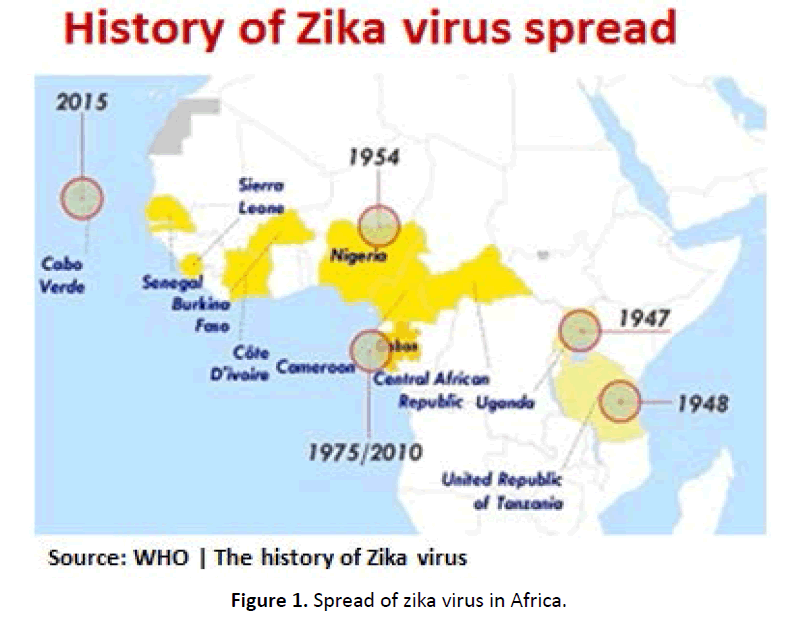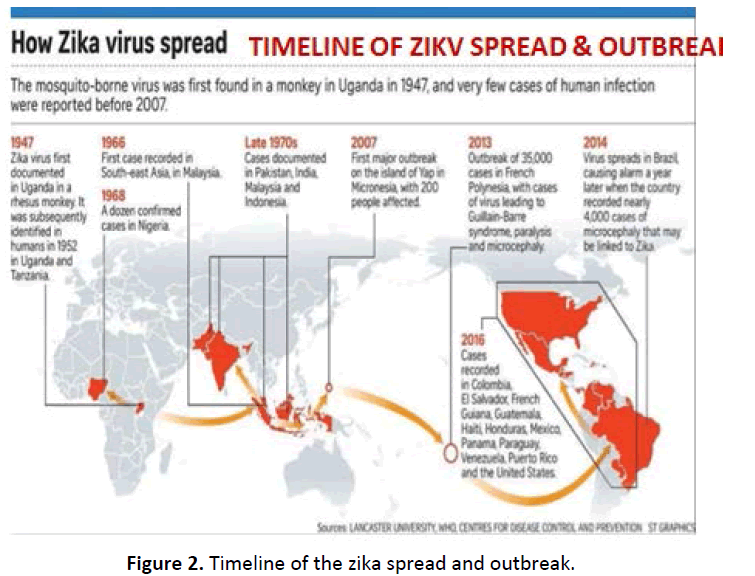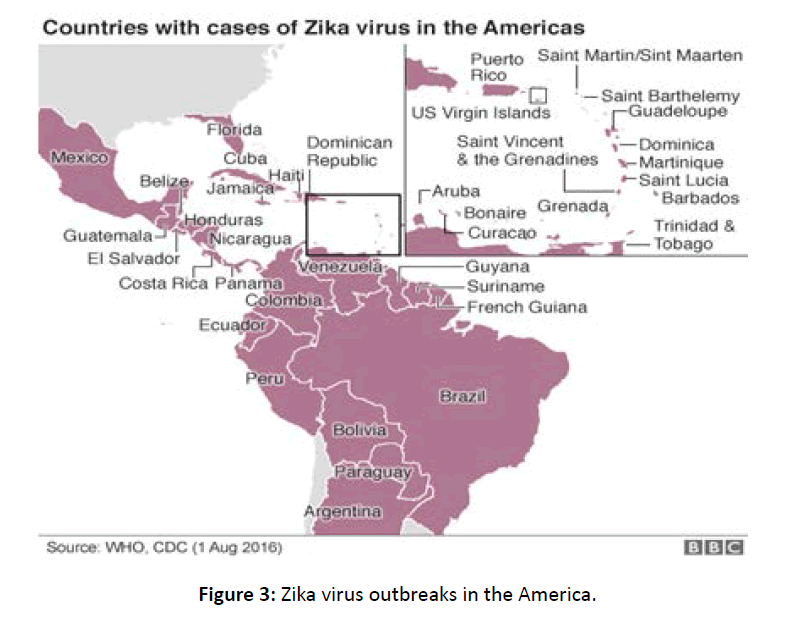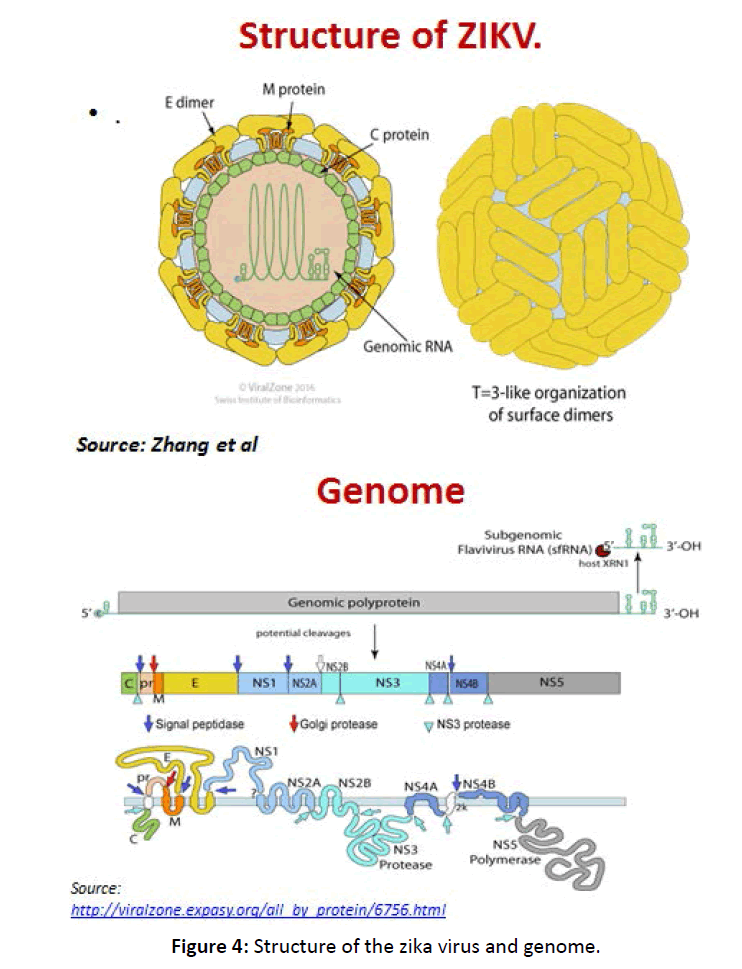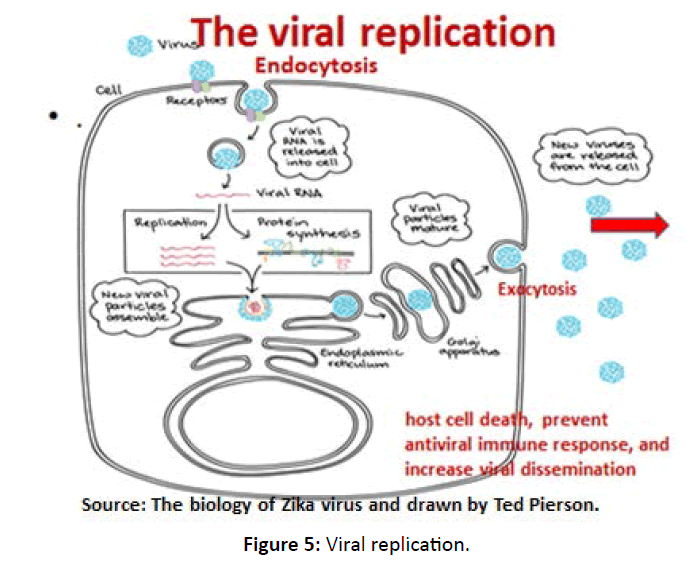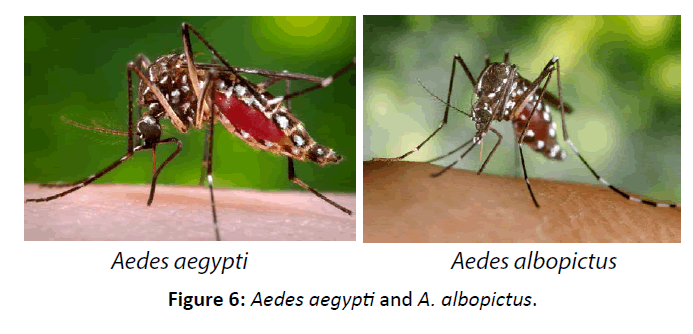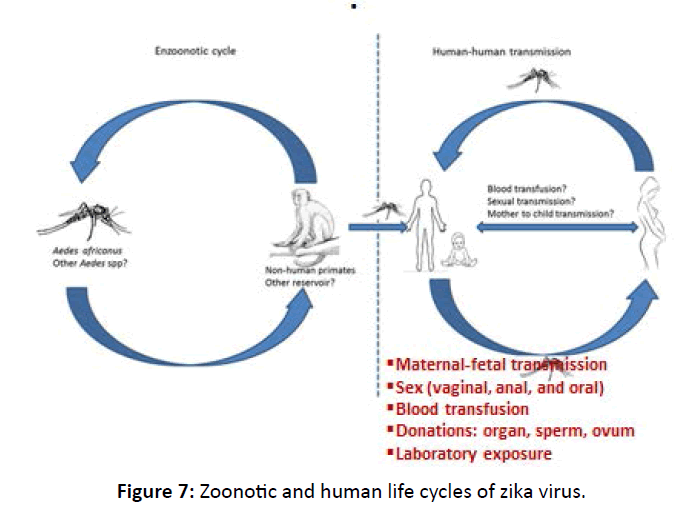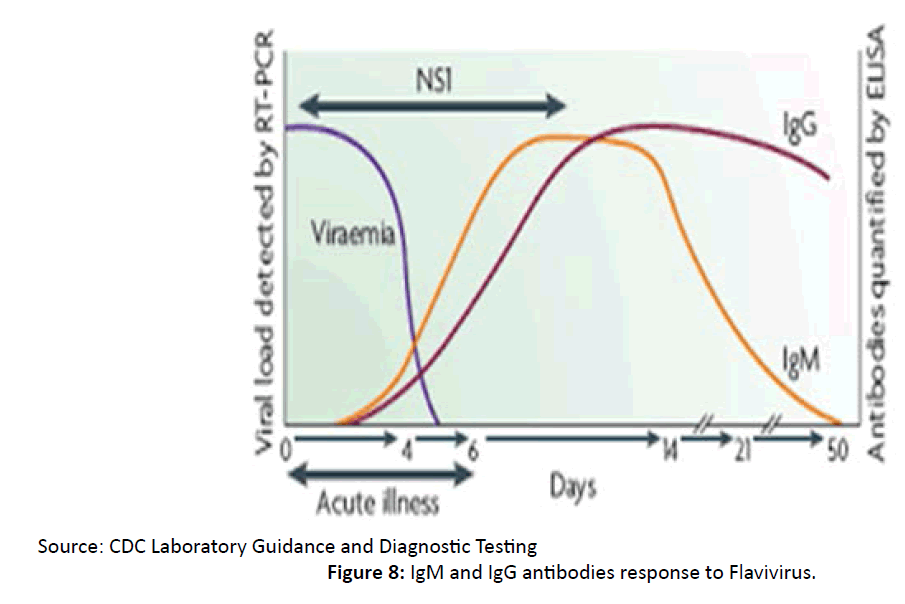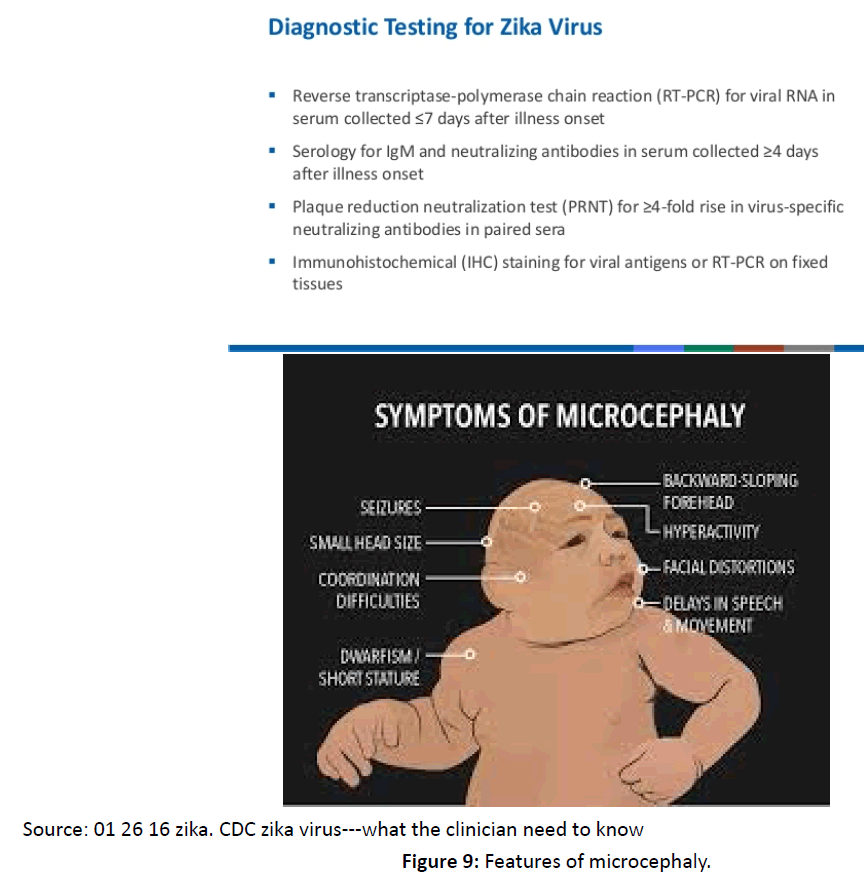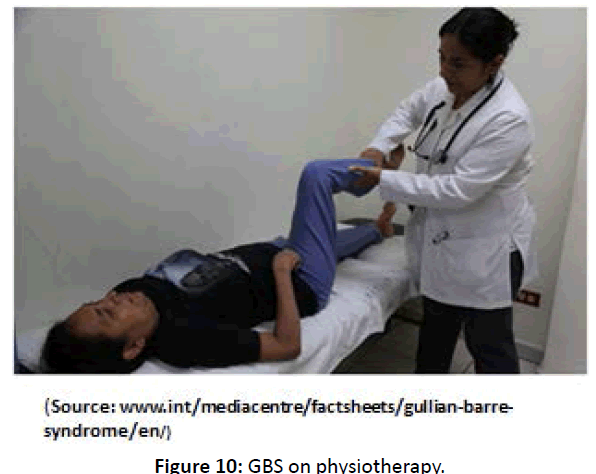Keywords
Zika virus; Congenital microcephaly challenge; Recommendation.
Origin and Spread of Zika virus
Zika virus is a Flavi virus like dengue, yellow fever, and West Nile viruses that is transmitted mostly by Aedes mosquitos. It was first isolated from a febrile rhesus monkey in the Zika forest of Uganda in 1947, but the virus was named after the forest in 1952[1]. Serosurvey studies in humans suggested wide spreads of the virus throughout Africa, Asia, and Oceania. In 1954, the first three cases of zika virus infection in human were reported in Oyo state, Nigeria[2]. Fagbami[3] noted in his study that 40% of Nigerian adults and 25% of Nigerian children have antibodies to zika virus.
For over 70 years, zika virus infections were characterized by being “harmless”, sporadic, subclinical, and presenting with mild-influenza-like symptoms in 20% of the cases. The first major outbreak was in 2007 in Yap Island (Federated States of Micronesia) where 73% of the population was infected, and 18% developed symptoms[4]. The second outbreak was in French Polynesia in 20135. Other outbreaks occurred in Cook Island[5], Easter Island[6], New Caledonia[7] and the current Americas8 as shown in Figures 1-3.
The current and ongoing "explosive spread with devastating neurological sequel" in the Americas, the Caribbean, and the Pacific made the World Health Organization (WHO) to declare zika virus “a Public Health Emergency of International Concern”[9]. In Brazil, 440,000-1,300,000 persons have been infected as of February 16, 2016. The current zika virus strain in Brazil is strongly linked to the current growing number (over 40% increases) of the neurologic complications of congenital microcephaly, and Guillain-Barré Syndrome (GBS).
Up to date, there is neither an antiviral drug to treat nor a vaccine to prevent zika virus. Currently, efforts are focused on preventing primary infections particularly in women tending to become pregnant. Several knowledge gaps and “rumors” exist about the zika virus especially with respect to its vectors and reservoirs, the pathogenesis of the associated complications, and potential effects of co-infection with other circulating viruses and chemicals.
Virology of the Zika virus
The structure of the zika virus is similar to other Flavi viruses like the Dengue, Yellow fever and West Nile viruses. A virion of the zika virus is about 40 nm in diameter, and has 5-10 nm surface projections arranged in an icosahedral symmetry. The C protein is surrounded by lipid bilayer proteins that contain the prM and E envelope proteins. It has a non-segmented, singlestranded, positive-sense RNA genome that has 10,794 bases, and two non-coding flanking regions, the 5′ NCR and the 3′ NCR. The other complex structures of the genome are as in Figure 4. The 3’ terminus has a sub-genomic Flavi virus RNA (sfRNA) structure that is essential for causing disease in humans[10]. The E protein composes the majority of the virion surface and is involved in the viral-host cell binding and membrane fusion during replication.
Zika Virus Replication
Viruses cannot replicate until they infect suitable host cells, and “reprogram” the cells to become virus-producing factories. Zika virus replicates in fibroblast, keratinocytes, and immature dendritic cells in the epidermis and dermis of the host skin. Multiplications occur in cytoplasm in mammals, and may be in the nucleus in insects. Zika virus replication involves:
1. Attachment of the viral envelope protein E to host receptors and internalization of the virion into the host cell by endocystosis. RNA genome is released into the cytoplasm.
2. The positive-sense genomic ssRNA is translated into a polyprotein, which is cleaved into all structural and nonstructural proteins of the virus. Replication takes place at the surface of endoplasmic reticulum in cytoplasmic viral factories.
Figure 1. Spread of zika virus in Africa.
Figure 2. Timeline of the zika spread and outbreak.
3. A dsRNA genome is synthesized from the genomic ssRNA (+). The dsRNA genome is transcribed/ replicated thereby providing viral mRNAs/new ssRNA (+) genomes.
4. Virus particles assemble and are processed at the endoplasmic reticulum and Golgi apparatus. The prM protein is cleaved in the Golgi, thereby maturing the virion and making it infective. Release of new virions by exocytosis leading to viremia and dissemination in the body fluid (Figure 5).
The Aedes Mosquito Vectors and Zika virus Transmission
The infected female Aedes aegypti and albopictus mosquitos transmit zika virus during their regular blood-feeds in primates including humans (Figure 6). The Aedes aegypti lives in tropical region, and is the main vector for the zika virus transmission in humans while Aedes albopictus lives in temperate regions. Both vectors also transmit yellow fever, dengue and chikungunya fever. They lay eggs in domestic stagnant water-holding containers and live in and around households. They are aggressive daytime biters with biting peaks during early morning and late afternoon/evening. Efficient control of these mosquitos has been a big challenge even with the new technology of genetically modified adults male Aedes mosquitoes infected with the Wolbachia bacteria[11].
Figure 3. Zika virus outbreaks in the America.
Figure 4. Structure of the zika virus and genome.
Figure 5. Viral replication.
Figure 6.Aedes aegypti and A. albopictus.
Figure 7.Zoonotic and human life cycles of zika virus.
There are zoonotic and human zika virus transmission life cycles (Figure 7).
The natural Zika virus transmissions occur during the bites of infected female Aedes mosquitos among primates in the forest. However, the virus is transmitted to human when the infected mosquito bites man. Other modes of transmission in humans include maternal-fetal transmission, sex, blood transfusion, and organ, ovum, and sperm donations, and during laboratory exposure. Following replication and viremia, Zika virus RNA has been detected in the blood, urine, semen, saliva, female genital tract secretions, cerebrospinal fluid, amniotic fluid and breast milk[12-14]. The testicles, placenta, fetus, eye and brain are the known immunologically privileged sites of the virus in the human body.
The Host Immune Response
Zika virus is recognized by the host cell immune system. The Toll-like receptors deregulate the host cells to produce interferons, inflammatory cytokines and chemokine to fight the disease. Anti- Zika virus IgG, IgM (Figure 8) and neutralization antibodies are also produced by the host cell. The antibodies are similar to other Flavi virus antibodies, cross-react with each other and can make specific diagnosis difficult.
The etiopathogenesis of the severity of the current zika virus outbreaks in the Americas is unclear and has many unanswered questions. The host cell immune response, and interactions with the circulating antibodies of other flavi viruses and chemicals may be implicated.
Diagnosis of Zika Virus
The clinical features are non-specific, and requires high index of suspicion to detect Zika virus infection and disease when there is no outbreaks. The incubation period of Zika virus disease is not clear, but is likely to be a few days. The symptoms are similar to other arbo virus infections such as dengue virus, and include fever, skin rashes in 65% cases, conjunctivitis, muscle and joint pain, malaise, and headache. These symptoms are usually mild and last for 2-7 days. History of travel to an affected area is important (Figure 9).
Major Complications of Zika Virus: Congenital Microcephaly and GBS
Congenital microcephaly
The scientific consensus is that Zika virus is strongly linked to the current increase in congenital microcephaly and Guillain- Barré syndrome in the Americas. The pathogenesis is, however, not clear. Damage caused by immune response to the brain tissue and nerves may be implicated.
In congenital microcephaly, the baby’s head is smaller (i.e., less than 2 standard deviation from the mean of other babies of the same age and sex) or head circumference <31.6 cm at birth. The brain stops growing. Congenital microcephaly can also be caused by Down syndrome, alcohol, tobacco smoking, radiation, toxic chemicals, rubella, toxoplasmosis and cytomegalo virus infection in pregnancy. Severe malnutrition and interruption of the blood supply to the baby’s brain during development can cause microcephaly. Measurements of the baby’s head circumference with ultrasound in pregnancy, and at birth can identify microcephaly cases. Gamut of health challenges including termination of zika virus babies faces the clinicians and the affected families. The features (Figure 9) and health challenges of congenital microcephaly include small head size, backward sloping of forehead, facial distortions, delayed speech and movement, seizures, coordination difficulty and short stature. Others include failure to thrive, poor appetite/feeding, unusually high-pitched crying, involuntary muscle contractions, learning disabilities, impaired motor function, movement and balance, vision and hearing problems and various forms of abuses, discrimination and even stigmatization. There is no specific treatment for microcephaly and the conditions are may be relative common in even in Africa.
Guillain-bare syndrome (GBS)
Figure 8.IgM and IgG antibodies response to Flavivirus.
Figure 9.Features of microcephaly.
GBS is a rare condition in which the person’s immune system attacks their peripheral nerves. It affects people of all ages, but commoner in adults and in males. Most people recover fully even from severe cases. Loss of sensation in glove and stocking fashion is characteristic for the disease. The paralysis may extend to the chest muscles in 20-25% cases causing difficulty in breathing. In some severe cases, the individual may be paralyzed with attendant loss of function/activity, reduced productivity, reduced societal value, increased psychological burden, increased economic burden and cost of care on the family. Supportive care, reassurance and physiotherapy (Figure 10) are the main treatments options. Respiratory support and other intensive care may occasionally be needed (Figure 10).
Other Identified Emerging Global Health Issues on Zika Virus Include
• The entire world population is at risk of infection (Globalization).
• There are no antiviral drugs or vaccines to combat the explosive spread.
• Our weak health system is most likely to collapse during such explosive epidemics in Nigeria.
• The economic impact will be alarming in terms of cost of care (e.g. microcephaly and GBS) and loss of working hours, reduced productivity, and occupational activities of the patients and their families.
• Efficient control of the mosquitos has been a big challenge.
• Disordered urban growth and environment, pollution of rivers and ditches, and stagnant water around household provide sites for the breeding and dissemination of mosquitos.
• Warm climate change may contribute to the extension of the mosquito vectors and zika virus infections to cold countries.
• The outbreaks of the zika virus challenge physicians, health professionals and researchers to develop public health strategies to combat the pandemic at individual, community and state levels.
• The “rumours” about zika virus and its complication must be dispelled, and the facts clearly stated as follow that[15]:
a. Bacteria used to control the male mosquito population are not spreading Zika further.
b. No evidence that Zika virus and its complications are linked to releases of genetically modified mosquitoes in Brazil.
Figure 10.GBS on physiotherapy.
c. No evidence that sterilized male mosquitoes contribute to the spread of Zika
d. No evidence that vaccines cause microcephaly in babies.
e. No evidence that pyriproxyfen insecticide causes microcephaly.
Recommendations
1. To mitigate the spread and impact of the zika virus, scientists must fill the critical gaps in the vector control and elimination.
2. Clinicians and other health scientists worldwide must be empowered to respond to zika virus outbreaks as the world did in the HIV/AIDS and Ebola virus.
3. Antiviral drugs and vaccines must be developed fast to combat the anticipated explosive spread.
4. The best prevention of zika virus infection is to prevent mosquito bites, and this can be done at personal, community and government levels[16].
The individuals can wear long sleeved, light coloured clothes covering as much of the body as possible, and as weather permits, use air conditioners, use of mosquito repellents, sleep days and nights under insecticide treated mosquito nets. Windows and doors mosquito nettings can keep mosquitoes outside the houses.
•• Communities and government can organize regular (weekly or monthly) environmental sanitation to clear the grass and gutters around the house, and discard cans/ old buckets/tyres, cover pots that contain waters for breeding mosquito. Environmental sprays and the use of biological vector control e.g. fish can be effective. Use of insecticides and mosquito nets should be promoted at the community to avoid under use[17]. Government should provide and equip viral diagnostic centers in every state to aid research and development on viral outbreak preventions.
Identified Areas of Further Research
1. Awareness of zika virus and its linked neurological complications among mothers.
2. Baseline head circumferences of babies at birth before the advent of zika virus infection
3. Can antinflamatory drugs and immune suppressors mitigate the complications of zika virus in pregnancy?
Conclusion
Zika virus spread to Nigeria and the entire world is a real global health threat. The enormity of the negative impacts on economy, productivity, education, and on the advances made on the Millieum Develpoment Goals, made the WHO to declare zika virus “a public health emergency of international concern”. Prevention of infected mosquito bites is the key strategy, and can be achieved through coordinated eradication the mosquitos, development antiviral drugs and vaccines. Individuals, families, communities, and governments participations and supports are essential to combat mosquito bites and zika virus spread.
References
- Dick GW, Kitchen SF, Haddow AJ (1952) Zika virus. Isolations and serological specificity. Trans R Soc Trop Med Hyg. 46: 509-520.
- MacNamara FN (1954) Zika virus: a report on three cases of human infection during an epidemic of jaundice in Nigeria. Trans R Soc Trop Med Hyg. 48:139-145.
- Fagbami AH (1979) Zika virus infectionin Nigeria: virology and seroepidemological investigation in Oyo stae. Journal of .Hygiene. 83: 213-219.
- Duffy MR, Chen TH, Hancock WT, Powers AM, Kool JL, et al. (2009) Zika virus outbreak on Yap Island, Federated States of Micronesia. N Engl J Med. 360: 2536-2543.
- Roth A, Mercier A, Lepers C, Hoy D, Duituturaga S, et al. (2014) Concurrent outbreaks of dengue, chikungunya and Zika virus infections - an unprecedented epidemic wave of mosquito-borne viruses in the Pacific 2012-2014. Euro Surveill. 19: 20929.
- Tognarelli J, Ulloa S, Villagra E, Lagos J, Aguayo C, et al. (2016) A report on the outbreak of Zika virus on Easter Island, South Pacific. Arch Virol. 161: 665-668.
- Dupont-Rouzeyrol M, O’Connor O, Calvez E, Daurès M, John M, et al. (2015) Co-infection with Zika and dengue viruses in 2patients, NewCaledonia. EmergInfectDis. 21: 381-382.
- Fauci AS, Morens DM (2016) Zika virus in the Americas—yet another arbovirus threat. N Engl J Med.
- 374: 601-604.
- Gulland A (2016) Zika virus is a global public health emergency, declares WHO. BMJ. 352: i657.
- Clarke BD, Roby JA, Slonchak A, Khromykh AA (2015) Functional non-coding RNAs derived from the flavivirus 3' untranslated region. Virus Res. 206: 53-61.
- World Health Organization/TDR (1991) Report of the meeting prospects for malaria control by genetic manipulation of its vectors. Tucson, USA.
- Musso D, Nhan T, Robin E (2014) Potential for Zika virus transmission through blood transfusion demonstrated during an outbreak in French Polynesia, November 2013 to February 2014. Euro Surveill. 19: 20761.
- https://www.cdc.gov/zika/transmission/index.html
- Prisant N, Bujan L, Benichou H (2016) Zika virus in the female genital tract. Lancet Infect Dis. 16: 1220.
- www.who.int/features/qa/zika/en/
- Osuorah DC, Ezudu CE, Onah SK, Anyabolu OT (2013) Household bet net ownership and use among under-5 children in Nigeria. Tropical Medicine. 4: 15-27.
- Ukibe SN, Mbanugo J, Ukibe NR, Ikeakor LC (2013) Level of awareness and use of insecticide treated bed nets among pregnant women attending antenatal clinics in Anambra State, South Eastern Nigeria. J Public Health Epidemiol. 5: 391-396.

